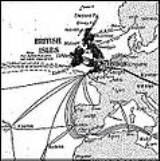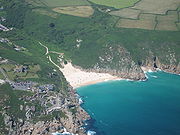
Porthcurno Telegraph Museum
Encyclopedia

Museum
A museum is an institution that cares for a collection of artifacts and other objects of scientific, artistic, cultural, or historical importance and makes them available for public viewing through exhibits that may be permanent or temporary. Most large museums are located in major cities...
located in the small coastal village of Porthcurno
Porthcurno
Porthcurno is a small village in the parish of St. Levan located in a valley on the south coast of the county of Cornwall, England in the United Kingdom. It is approximately to the west of the market town of Penzance and about from Land's End, the most westerly point of the English mainland...
Cornwall
Cornwall
Cornwall is a unitary authority and ceremonial county of England, within the United Kingdom. It is bordered to the north and west by the Celtic Sea, to the south by the English Channel, and to the east by the county of Devon, over the River Tamar. Cornwall has a population of , and covers an area of...
, UK. Porthcurno was the point at which many submarine telegraph cables—transatlantic
Transatlantic telegraph cable
The transatlantic telegraph cable was the first cable used for telegraph communications laid across the floor of the Atlantic Ocean. It crossed from , Foilhommerum Bay, Valentia Island, in western Ireland to Heart's Content in eastern Newfoundland. The transatlantic cable connected North America...
and to other locations—came ashore. The museum, which opened in May 1998, is housed in the former telegraph facility.
History

SS Great Eastern
SS Great Eastern was an iron sailing steam ship designed by Isambard Kingdom Brunel, and built by J. Scott Russell & Co. at Millwall on the River Thames, London. She was by far the largest ship ever built at the time of her 1858 launch, and had the capacity to carry 4,000 passengers around the...
liner made by Isambard Kingdom Brunel
Isambard Kingdom Brunel
Isambard Kingdom Brunel, FRS , was a British civil engineer who built bridges and dockyards including the construction of the first major British railway, the Great Western Railway; a series of steamships, including the first propeller-driven transatlantic steamship; and numerous important bridges...
was employed as a cable laying ship.
Its size made it the first choice to lay the original cables that linked the administrative outposts of the British Empire
British Empire
The British Empire comprised the dominions, colonies, protectorates, mandates and other territories ruled or administered by the United Kingdom. It originated with the overseas colonies and trading posts established by England in the late 16th and early 17th centuries. At its height, it was the...
. The first European cable was not a success, its small diameter created too great a resistance to the voltage used and the signal was too weak to be reliable. An attempt to increase the voltage pressure resulted in insulation breakdown and subsequent failure of the telegraph link. The cables are heavily armoured for protection against damage as they come ashore, a lighter construction technique is used at depth on the ocean floor. Modern cables are usually Fibre optic and are much lighter in construction, international information is now made available of the locations of submarine cables. When the system was completed, central government in Britain had a method of effective communication with its civil servants and military commanders throughout the world. At the outbreak of World War II
World War II
World War II, or the Second World War , was a global conflict lasting from 1939 to 1945, involving most of the world's nations—including all of the great powers—eventually forming two opposing military alliances: the Allies and the Axis...
, the existing surface installations were thought to be far too vulnerable to attack, and in 1941, miners were employed to cut tunnels into the solid granite of the valley's hillside to house the telegraphy
Telegraphy
Telegraphy is the long-distance transmission of messages via some form of signalling technology. Telegraphy requires messages to be converted to a code which is known to both sender and receiver...
equipment. Porthcurno telegraphy facility closed in 1970, 100 years after it first began its operations.
Museum development
The museum was started by former employees of Cable and Wireless based at the company's Holborn headquarters in London. It is now located in the previously excavated tunnels near Porthcurno beach, Cornwall. The layout of the museum display was carried out after receiving a grant from the Heritage Lottery FundHeritage Lottery Fund
The Heritage Lottery Fund is a fund established in the United Kingdom under the National Lottery etc. Act 1993. The Fund opened for applications in 1994. It uses money raised through the National Lottery to transform and sustain the UK’s heritage...
.
The museum has displays showing the history of submarine cable-laying ships and telegraphy, and a variety of samples of cable designs used throughout its long history. The museum has a varied collection of still-working equipment designed for telegraphy. It remained a training college for the communications industry until 1993. An Exeter University project known as "Connecting Cornwall" was funded to promote a new exhibition known as the "Nerve centre of Empire". This was opened in the summer of 2010 in the presence of the Princess Royal
Princess Royal
Princess Royal is a style customarily awarded by a British monarch to his or her eldest daughter. The style is held for life, so a princess cannot be given the style during the lifetime of another Princess Royal...
. The new exhibition aims to be an educational experience for children, and has included suitable artwork provided by a local artist. There are now up to 13 people manning the museum and dealing with a constant flow of research and visitor enquiries using the modern equivalent of the old "Victorian Internet".

